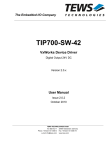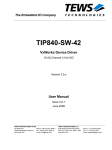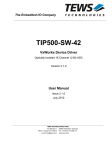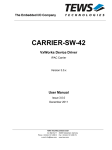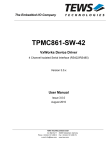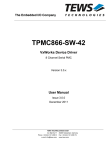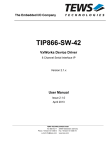Download User Manual - TEWS Bentech Taiwan
Transcript
The Embedded I/O Company TIP675-SW-42 VxWorks Device Driver 48 TTL I/O Lines with Interrupts Version 2.0.x User Manual Issue 2.0.0 July 2010 TEWS TECHNOLOGIES GmbH Am Bahnhof 7 25469 Halstenbek, Germany Phone: +49 (0) 4101 4058 0 Fax: +49 (0) 4101 4058 19 e-mail: [email protected] www.tews.com TIP675-SW-42 This document contains information, which is proprietary to TEWS TECHNOLOGIES GmbH. Any reproduction without written permission is forbidden. VxWorks Device Driver 48 TTL I/O Lines with Interrupts TEWS TECHNOLOGIES GmbH has made any effort to ensure that this manual is accurate and complete. However TEWS TECHNOLOGIES GmbH reserves the right to change the product described in this document at any time without notice. Supported Modules: TIP675 TEWS TECHNOLOGIES GmbH is not liable for any damage arising out of the application or use of the device described herein. 2002-2010 by TEWS TECHNOLOGIES GmbH Issue Description Date 1.0 First Issue September 12, 2002 1.1.0 IPAC Carrier Driver Support January 11, 2006 1.2.0 New Address TEWS TECHNOLOGIES LLC ChangeLog.txt added to file list, new error code for tip675DevCreate() December 5, 2006 1.2.1 Carrier Driver description added June 24, 2008 2.0.0 SMP Support, IPAC carrier interface functions removed, return value for ioctl function changed July 26, 2010 TIP675-SW-42 – VxWorks Device Driver Page 2 of 26 Table of Contents 1 INTRODUCTION......................................................................................................... 4 1.1 Device Driver ...................................................................................................................................4 1.2 IPAC Carrier Driver .........................................................................................................................5 2 INSTALLATION.......................................................................................................... 6 2.1 Include device driver in VxWorks projects ..................................................................................6 2.2 System resource requirement .......................................................................................................6 3 I/O SYSTEM FUNCTIONS.......................................................................................... 7 3.1 tip675Drv() .......................................................................................................................................7 3.2 tip675DevCreate()............................................................................................................................9 4 I/O FUNCTIONS ....................................................................................................... 11 4.1 open() .............................................................................................................................................11 4.2 close().............................................................................................................................................13 4.3 ioctl() ..............................................................................................................................................15 4.3.1 FIO_T675_READ ...............................................................................................................17 4.3.2 FIO_T675_WRITE .............................................................................................................18 4.3.3 FIO_T675_SET_DIR..........................................................................................................19 4.3.4 FIO_T675_INSTALL_ISF...................................................................................................20 4.3.5 FIO_T675_REMOVE_ISF..................................................................................................23 4.3.6 FIO_T675_ENA_EXCLK....................................................................................................25 4.3.7 FIO_T675_DIS_EXCLK .....................................................................................................26 TIP675-SW-42 – VxWorks Device Driver Page 3 of 26 1 Introduction 1.1 Device Driver The TIP675-SW-42 VxWorks device driver software allows the operation of the TIP675 IP conforming to the VxWorks I/O system specification. This includes a device-independent basic I/O interface with open(), close() and ioctl() functions. The TIP675 driver includes the following functions: reading the input register writing the output register programming direction of every I/O line configure simultaneous update feature connect interrupt callback functions to every I/O line Support for legacy and VxBus IPAC carrier driver SMP Support The TIP675-SW-42 supports the modules listed below: TIP675-10 48 TTL I/O Lines with Interrupts IndustryPack® compatible To get more information about the features and use of the supported devices it is recommended to read the manuals listed below. TIP675 User manual TIP675 Engineering Manual CARRIER-SW-42 IPAC Carrier User Manual TIP675-SW-42 – VxWorks Device Driver Page 4 of 26 1.2 IPAC Carrier Driver IndustryPack (IPAC) carrier boards have different implementations of the system to IndustryPack bus bridge logic, different implementations of interrupt and error handling and so on. Also, the different byte ordering (big-endian versus little-endian) of CPU boards might cause problems when accessing the IndustryPack I/O and memory spaces. To simplify the implementation of IPAC device drivers which shall work with any supported carrier board, TEWS TECHNOLOGIES has designed a so called Carrier Driver that hides all differences of different carrier boards under a well defined interface. The TEWS TECHNOLOGIES IPAC Carrier Driver CARRIER-SW-42 is part of this TIP675-SW-42 distribution. It is located in the directory ‘/CARRIER-SW-42/’ on the corresponding distribution media. This IPAC Device Driver requires a properly installed IPAC Carrier Driver. Due to the design of the Carrier Driver, it is sufficient to install the IPAC Carrier Driver once, even if multiple IPAC Device Drivers are used. Please refer to the CARRIER-SW-42 User Manual for a detailed description on how to install and setup the CARRIER-SW-42 device driver, and for a description of the TEWS TECHNOLOGIES IPAC Carrier Driver concept. TIP675-SW-42 – VxWorks Device Driver Page 5 of 26 2 Installation The following files and directories are located on the distribution media: Directory path ‘./TIP675-SW-42/’: tip675drv.c tip675def.h tip675.h tip675exa.c include/ipac_carrier.h TIP675-SW-42-2.0.0.pdf Release.txt ChangeLog.txt TIP675 device driver source TIP675 driver include file TIP675 include file for driver and application Example application Carrier driver interface definitions PDF copy of this manual Release information Release history 2.1 Include device driver in VxWorks projects For including the TIP675-SW-42 device driver into a VxWorks project (e.g. Tornado IDE or Workbench) follow the steps below: (1) Copy the files from the distribution media into a subdirectory in your project path. (For example: TIP675) (2) Add the device drivers C-files to your project. (3) Now the driver is included in the project and will be built with the project. For a more detailed description of the project facility please refer to your VxWorks User’s Guide (e.g. Tornado, Workbench, etc.) 2.2 System resource requirement The table gives an overview over the system resources that will be needed by the driver. Resource Driver requirement Devices requirement Memory < 1 KB < 1 KB Stack < 1 KB < 1 KB Semaphores --- --- Memory and Stack usage may differ from system to system, depending on the used compiler and its setup. The following formula shows the way to calculate the common requirements of the driver and devices. <total requirement> = <driver requirement> + (<number of devices> * <device requirement>) The maximum usage of some resources is limited by adjustable parameters. If the application and driver exceed these limits, increase the according values in your project. TIP675-SW-42 – VxWorks Device Driver Page 6 of 26 3 I/O system functions This chapter describes the driver-level interface to the I/O system. The purpose of these functions is to install the driver in the I/O system, add and initialize devices. 3.1 tip675Drv() NAME tip675Drv() - installs the TIP675 driver in the I/O system SYNOPSIS #include “tip675.h” STATUS tip675Drv(void) DESCRIPTION This function initializes the TIP675 driver and installs it in the I/O system. The call of this function is the first thing the user has to do before adding any device to the system or performing any I/O request. EXAMPLE #include "tip675.h” … status = tip675Drv(); if (status == ERROR) { /* Error handling */ } RETURNS OK or ERROR. If the function fails, an error code will be stored in errno. TIP675-SW-42 – VxWorks Device Driver Page 7 of 26 ERROR CODES The error code can be read with the function errnoGet(). The error code is a standard error code set by the I/O system (see VxWorks Reference Manual). SEE ALSO VxWorks Programmer’s Guide: I/O System TIP675-SW-42 – VxWorks Device Driver Page 8 of 26 3.2 tip675DevCreate() NAME tip675DevCreate() – Add a TIP675 device to the VxWorks system SYNOPSIS #include “tip675.h” STATUS tip675DevCreate ( char *name, int devIdx, int funcType, void *pParam ) DESCRIPTION This routine adds a TIP675 device to the VxWorks system. The device hardware will be setup and prepared for use. This function must be called before performing any I/O request to this device. PARAMETER name This string specifies the name of the device that will be used to identify the device, for example for open() calls. devIdx This index number specifies the desired device instance beginning by 0. This parameter is 0 for the first TIP675 in the system, 1 for the second TIP675 and so forth. The order of TIP675 modules depends on the search order of the IPAC carrier driver. funcType This parameter is unused and should be set to 0. pParam This parameter is unused and should be set to NULL. TIP675-SW-42 – VxWorks Device Driver Page 9 of 26 EXAMPLE #include "tip675.h” … STATUS result; /*--------------------------------------------------------Create the device "/tip675/0" for the first TIP675 module ---------------------------------------------------------*/ result = tip675DevCreate("/tip675/0", 0, 0, NULL); if (result == ERROR) { /* Error occurred when creating the device */ }… RETURNS OK or ERROR. If the function fails, an error code will be stored in errno. ERROR CODES The error codes can be read with the function errnoGet(). Error code Description S_ioLib_NO_DRIVER Driver not installed, call tip675Drv() first. S_tip675Drv_IARG The parameter devIdx is out of range S_tip675Drv_EXISTS The TIP675 device specified by the parameter devIdx has been created already. ENXIO No TIP675 module found for the specified parameter devIdx. If this error occurred for parameter devIdx=0, no TIP675 module at all was recognized. SEE ALSO VxWorks Programmer’s Guide: I/O System TIP675-SW-42 – VxWorks Device Driver Page 10 of 26 4 I/O Functions 4.1 open() NAME open() - open a device or file. SYNOPSIS int open ( const char int int ) *name, flags, mode DESCRIPTION Before I/O can be performed to the TIP675 device, a file descriptor must be opened by invoking the basic I/O function open(). PARAMETER name Specifies the device which shall be opened, the name specified in tip675DevCreate() must be used flags Not used mode Not used TIP675-SW-42 – VxWorks Device Driver Page 11 of 26 EXAMPLE int fd; /*-----------------------------------------Open the device named "/tip675/0" for I/O ------------------------------------------*/ fd = open("/tip675/0", 0, 0); if (fd == ERROR) { /* Handle error */ } RETURNS A device descriptor number or ERROR. If the function fails, an error code will be stored in errno. ERROR CODES The error code can be read with the function errnoGet(). The error code is a standard error code set by the I/O system (see VxWorks Reference Manual). SEE ALSO ioLib, basic I/O routine - open() TIP675-SW-42 – VxWorks Device Driver Page 12 of 26 4.2 close() NAME close() – close a device or file SYNOPSIS int close ( int ) fd DESCRIPTION This function closes opened devices. PARAMETER fd This file descriptor specifies the device to be closed. The file descriptor has been returned by the open() function. EXAMPLE int STATUS fd; result; /*---------------close the device ----------------*/ result = close(fd); if (result == ERROR) { /* Handle error */ } TIP675-SW-42 – VxWorks Device Driver Page 13 of 26 RETURNS OK or ERROR. If the function fails, an error code will be stored in errno. ERROR CODES The error code can be read with the function errnoGet(). The error code is a standard error code set by the I/O system (see VxWorks Reference Manual). SEE ALSO ioLib, basic I/O routine - close() TIP675-SW-42 – VxWorks Device Driver Page 14 of 26 4.3 ioctl() NAME ioctl() - performs an I/O control function. SYNOPSIS #include “tip675.h” int ioctl ( int int int ) fd, request, arg DESCRIPTION Special I/O operations that do not fit to the standard basic I/O calls will be performed by calling the ioctl function with a specific function code and an optional function dependent argument. For details of supported ioctl functions see VxWorks Reference Manual: VxWorks Programmer’s Guide: I/O system. PARAMETER fd This file descriptor specifies the device to be used. The file descriptor has been returned by the open() function. request This argument specifies the function that shall be executed. Following functions are defined: Function Description FIO_T675_READ Read from input buffer FIO_T675_WRITE Write to output buffer FIO_T675_SET_DIR Set direction of I/O lines FIO_T675_INSTALL_ISF Install user supplied I/O service function at specified I/O line FIO_T675_REMOVE_ISF Remove user supplied I/O service function from specified I/O line FIO_T675_ENA_EXCLK Enable simultaneous update feature FIO_T675_DIS_EXCLK Disable simultaneous update feature TIP675-SW-42 – VxWorks Device Driver Page 15 of 26 arg This parameter depends on the selected function (request). How to use this parameter is described below with the function. RETURNS OK or ERROR. If the function fails, an error code will be stored in errno. ERROR CODES The error code can be read with the function errnoGet(). The error code is a standard error code set by the I/O system (see VxWorks Reference Manual). Function specific error codes will be described with the function. SEE ALSO ioLib, basic I/O routine - ioctl() TIP675-SW-42 – VxWorks Device Driver Page 16 of 26 4.3.1 FIO_T675_READ This function reads the current contents of the input registers of the TIP675 associated with the device descriptor fd into the read buffer of type T675_READ_STR. The function specific control parameter arg is a pointer to a T675_READ_STR structure. typedef struct { unsigned short unsigned short unsigned short } T675_READ_STR; in_1_16; in_17_32; in_33_48; in_1_16 Returns the contents of the input register for I/O-line 1 up to 16. (Line 1 is assigned to bit 0, line 2 to bit 1 and so on.) in_17_32 Returns the contents of the input register for I/O-line 17 up to 32. (Line 17 is assigned to bit 0, line 18 to bit 1 and so on.) in_33_48 Returns the contents of the input register for I/O-line 33 up to 48. (Line 33 is assigned to bit 0, line 34 to bit 1 and so on.) EXAMPLE #include "tip675.h" … int fd; int retval; T675_READ_STR rBuf; /*--------------------------------------------------------read the input registers of the device associated with fd ---------------------------------------------------------*/ retval = ioctl (fd, FIO_T675_READ, (int)&rBuf); if (retval == OK) { printf( “Input 1-16: %04X\n”, rBuf.in_1_16 ); printf( “Input 17-32: %04X\n”, rBuf.in_17_32 ); printf( “Input 33-48: %04X\n”, rBuf.in_33_48 ); } TIP675-SW-42 – VxWorks Device Driver Page 17 of 26 4.3.2 FIO_T675_WRITE This function writes to the output registers of the TIP675 associated with the device descriptor fd from a write buffer of type T675_WRITE_STR. The function specific control parameter arg is a pointer to a T675_WRITE_STR structure. typedef struct { unsigned short unsigned short unsigned short } T675_WRITE_STR; out_1_16; out_17_32; out_33_48; out_1_16 Specifies the output value that will be written into the output register for I/O-lines 1 up to 16 (Line 1 is assigned to bit 0, line 2 to bit 1 and so on). out_17_32 Specifies the output value that will be written into the output register for I/O-lines 17 up to 32 (Line 17 is assigned to bit 0, line 18 to bit 1 and so on). out_33_48 Specifies the output value that will be written into the output register for I/O-lines 33 up to 48 (Line 33 is assigned to bit 0, line 34 to bit 1 and so on). EXAMPLE #include "tip675.h" … int fd; int retval T675_WRITE_STR wBuf; /*------------------------------------------------------write to the output registers -------------------------------------------------------*/ wBuf.out_1_16 = 0x9abc; wBuf.out_17_32 = 0x5678; wBuf.out_33_48 = 0x1234; retval = ioctl(fd, FIO_T675_WRITE, (int)&wBuf); if (retval == ERROR) { /* handle function specific error conditions */ } TIP675-SW-42 – VxWorks Device Driver Page 18 of 26 4.3.3 FIO_T675_SET_DIR With this ioctl function, each of the 48 I/O lines may be individually set as input or output. After driver startup, all I/O lines are set to be inputs. To enable a certain output line, set the corresponding bit in the mask to 1. The function specific control parameter arg is a pointer to a T675_DIRECTION_STR structure. typedef struct { unsigned short unsigned short unsigned short } T675_DIRECTION_STR; dir_1_16; dir_17_32; dir_33_48; dir_1_16 Specifies the line direction for I/O-lines 1 up to 16 (Line 1 is assigned to bit 0, line 2 to bit 1 and so on). dir_17_32 Specifies the line direction for I/O-lines 17 up to 32 (Line 17 is assigned to bit 0, line 18 to bit 1 and so on). dir_33_48 Specifies the line direction for I/O-lines 33 up to 48 (Line 33 is assigned to bit 0, line 34 to bit 1 and so on). EXAMPLE #include "tip675.h" … int fd; int retval; T675_DIRECTION_STR dBuf; /*---------------------------------Set direction: Line 1-24 – output Line 25-32 – input ----------------------------------*/ dBuf.out_1_16 = 0xFFFF; dBuf.out_17_32 = 0x00FF; dBuf.out_33_48 = 0x0000; retval = ioctl(fd, FIO_T675_SET_DIR, (int)&dBuf); if (retval == ERROR) { /* handle function specific error conditions */ } TIP675-SW-42 – VxWorks Device Driver Page 19 of 26 4.3.4 FIO_T675_INSTALL_ISF This ioctl function connects a user supplied function to an interrupt at the specified I/O line. Each time an interrupt occurred with the specified transition at the specified I/O line, this function will be called. Only one callback function can be installed per I/O line and transition at the same time. The callback function will be invoked in supervisor mode at interrupt level. Be sure that only suitable system functions will be called and no wait conditions do occur. The function specific control parameter arg is a pointer to a T675_INSTALL_ISF_STR structure typedef struct { unsigned short unsigned short unsigned long VOIDFUNCPTR } T675_INSTALL_ISF_STR; io_line; edge; arg; funcPtr; io_line Specifies the I/O-line at which the callback function will be installed. Valid I/O lines are in range from 1 to 48. edge Specifies the transition (positive, negative) at which the callback function will be installed. Valid values are: Value Description T675_POS_EDGE An interrupt will be generated on a Low to High transition T675_NEG_EDGE An interrupt will be generated on a High to Low transition arg th This user defined argument will be passed in the 4 argument to the user supplied callback function. This argument could be a semaphore ID, a message ID or something like that. funcPtr This parameter contains a pointer to a function to be called if the interrupt at the connected I/O line occurred. The routine is invoked in supervisor mode at interrupt level. A proper C environment is established, the necessary registers saved, and the stack is set up. The function prototype of the callback function has the following arguments described below. void callback ( unsigned long unsigned long T675_READ_STR unsigned long ); base, line_info, *inBuf, arg TIP675-SW-42 – VxWorks Device Driver Page 20 of 26 base Base address of the modules I/O space. This argument is available for compatibility purposes only and it is not recommended to be used. line_info The lower 16-bit contains the number of the I/O-line (1...48) at which the event occurred. The upper 16-bit contains a flag which specifies the transition on which this interrupt was generated. The corresponding macros are the same as used for the parameter edge in the T675_INSTALL_ISF_STR structure. Please note these flags are left shifted by 16 bits. inBuf This argument is a pointer to a read buffer of type T675_READ_STR. The buffer is filled with the contents of the line input registers directly on entrance of the drivers interrupt service routine. The read buffer is placed on the interrupt stack and only available in the interrupt context. Due to the fact that the input registers aren’t latched, the input buffer doesn’t reflect the state of the input lines at the moment of the transition. The read is delayed by the interrupts latency which depends on the system performance and other functions which may block the interrupt processing. arg User supplied argument. EXAMPLE #include "tip675.h" … /*----------------------------CALLBACK FUNCTION (INTERRUPT) -----------------------------*/ static void callback ( unsigned long base, unsigned long line_info, T675_READ_STR *pvalue, unsigned long arg ) { int line; line = line_info & 0xffff; /* mask lower 16 bit */ if (((line_info>>16) & T675_POS_EDGE) != 0) { /* yes, this was a rising edge */ } /* do whatever necessary to handle this interrupt */ } TIP675-SW-42 – VxWorks Device Driver Page 21 of 26 /*---------------USER APPLICATION ----------------*/ … int int T675_INSTALL_ISF_STR fd; retval; IsfPar; /*------------------------------------------------------Install a callback function for line 12 interrupts. The function will be called if a rising edge occurred. The user argument is not used (0). -------------------------------------------------------*/ IsfPar.io_line = 12; IsfPar.edge = T675_POS_EDGE; IsfPar.funcPtr = callback; IsfPar.arg = 0; retval = ioctl(fd, FIO_T675_INSTALL_ISF, (int)&IsfPar); if (retval == ERROR) { /* handle function specific error conditions */ } ERRORS CODES S_t675Drv_ILINE Specified I/O line out of range. S_t675Drv_IPARAM No valid transition parameter S_t675Drv_BUSY This I/O line and edge combination is already occupied. Call the ioctl function FIO_T675_REMOVE_ISF to remove the previous installed callback function. TIP675-SW-42 – VxWorks Device Driver Page 22 of 26 4.3.5 FIO_T675_REMOVE_ISF This ioctl function removes a previously installed callback function from a specified I/O line and transition edge. The function specific control parameter arg is a pointer to a T675_INSTALL_ISF_STR structure. typedef struct { unsigned short unsigned short } T675_REMOVE_ISF_STR; io_line; edge; io_line Specifies the I/O-line number from which the callback function shall be removed. Valid I/O lines are in range from 1 to 48. edge Specifies the transition edge from which the callback function shall be removed. Valid values are: Value Description T675_POS_EDGE Rising edge (low to high transition) T675_NEG_EDGE Falling edge (high to low transition) EXAMPLE #include "tip675.h" … int int T675_REMOVE_ISF_STR fd; retval; RsfPar; /*------------------------------------------------------Remove user supplied callback function from I/O line 24 -------------------------------------------------------*/ RsfPar.io_line = 24; RsfPar.edge = T675_POS_EDGE; retval = ioctl(fd, FIO_T675_REMOVE_ISF, (int)&RsfPar); if (retval == ERROR) { /* handle function specific error conditions */ } TIP675-SW-42 – VxWorks Device Driver Page 23 of 26 ERROR CODES S_t675Drv_ILINE Specified I/O line out of range. S_t675Drv_IPARAM No valid transition parameter TIP675-SW-42 – VxWorks Device Driver Page 24 of 26 4.3.6 FIO_T675_ENA_EXCLK This ioctl function enables the simultaneous update feature of the TIP675. Setting the ioctl argument arg to T675_POS_EDGE will cause the inputs and outputs to be latched on the rising edge of the external clock, while setting arg to T675_NEG_EDGE will latch the inputs and outputs on the falling edge. EXAMPLE #include "tip675.h" … int int fd; retval; /*-----------------------------------------Enable simultaneous update on falling edge ------------------------------------------*/ retval = ioctl(fd, FIO_T675_ENA_EXCLK, T675_NEG_EDGE); if (retval == ERROR) { /* handle function specific error conditions */ } TIP675-SW-42 – VxWorks Device Driver Page 25 of 26 4.3.7 FIO_T675_DIS_EXCLK This ioctl function disables the simultaneous update feature of the TIP675. After driver startup the simultaneous update feature is disabled. The optional argument arg shall be set to 0. EXAMPLE #include "tip675.h" … int int fd; retval; /*------------------------------------------------Disable simultaneous update of inputs and outputs -------------------------------------------------*/ retval = ioctl(fd, FIO_T675_DIS_EXCLK, 0); if (retval == ERROR) { /* handle function specific error conditions */ } TIP675-SW-42 – VxWorks Device Driver Page 26 of 26


























